A solid conducting sphere is given a positive charge Q. How is the
charge Q distributed in or on the sphere?
(A) It is concentrated
at the center of the sphere.
(B) It is uniformly distributed
throughout the sphere.
(C) Its density decreases radially outward
from the center.
(D) It is uniformly distributed on the surface
of the sphere only
(D)
A parallel–plate capacitor is charged by connection to a battery. If
the battery is disconnected and the separation
between the plates
is increased, what will happen to the charge on the capacitor and the
voltage across it?
(A) Both remain fixed.
(B) Both increase.
(C) The charge increases and the voltage decreases.
(D) The charge remains fixed and the voltage increases.
(D)
One joule of work is needed to move one coulomb of charge from one
point to another with no change in
velocity. Which of the
following is true between the two points?
(A) The current is one
ampere.
(B) The potential difference is one volt. (C) The
electric field strength is one newton per coulomb.
(D) The
electric field strength is one joule per electron.
(B)
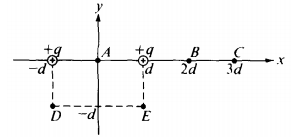
Two positive charges of magnitude q are each a distance d from the
origin A of a coordinate system as shown
above.
At which of the following points is the electric field least
in magnitude?
(A) A (B) B (C) C (D) D
(A)

Two positive charges of magnitude q are each a distance d from the
origin A of a coordinate system as shown
above.
At which of the following points is the electric potential
greatest in magnitude?
(A) A (B) B (C) C (D) D
(A)
A parallel–plate capacitor has a capacitance Co. A second
parallel–plate capacitor has plates with twice the area
and twice
the separation. The capacitance of the second capacitor is most
nearly
(A) ¼Co (B) Co (C) 2Co (D) 4Co
(B)

Two identical conducting spheres are charged to +2Q and –Q.
respectively, and are separated by a distance d (much greater than the
radii of the spheres) as shown above. The magnitude of the force of
attraction on the left sphere is F1. After the two spheres are made to
touch and then are re-separated by distance d, the magnitude
of
the force on the left sphere is F2.
Which of the following relationships is correct?
(A) 2F1
= F2 (B) F1 = F2 (C) F1 = 2F2 (D) F1 = 8 F2
(D)
The capacitance of a parallel–plate capacitor can be increased by
increasing which of the following?
(A) The distance between the
plates (B) The charge on each plate (C) The area of the
plates
(D) The potential difference across the plates
(C)
A hollow metal sphere of radius R is positively charged. Of the
following distances from the center of the sphere, which location will
have the greatest electric field strength?
(A) 0 (center of the
sphere) (B) 3R/2 (C) 2R
(D) None of the above because the field
is of constant strength
(B)
Two isolated charges, + q and – 2q, are 2 centimeters apart. If F is the magnitude of the force acting on charge –2Q, what are the magnitude and direction of the force acting on charge +q?
Magnitude
Direction
(A) (1/2) F Toward charge –
2q
(B) 2 F Away from charge –2q
(C) F Toward charge –
2q
(D) F Away from charge – 2q
(C)

Charges +Q and -4Q are situated as shown above. The net electric field is zero nearest which point?
- A
- C
- D
- E
(A)
A positive charge of 10–6 coulomb is placed on an insulated solid
conducting sphere. Which of the following is true?
(A) The charge
resides uniformly throughout the sphere.
(B) The electric field
in the region surrounding the sphere increases with increasing
distance from the sphere.
(C) An insulated metal object acquires
a net positive charge when brought near to, but not in contact with,
the
sphere.
(D) When a second conducting sphere is connected
by a conducting wire to the first sphere, charge is
transferred
until the electric potentials of the two spheres are equal.
(D)
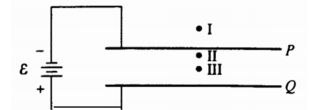
Two large parallel conducting plates P and Q are connected to a
battery of emf E, as shown above.
A test charge is placed
successively at points I, II, and III. If edge effects are negligible,
the force on the charge when it is at point III is
(A) of equal
magnitude and in the same direction as the force on the charge when it
is at point I
(B) of equal magnitude and in the same direction as
the force on the charge when it is at point II
(C) much greater
in magnitude than the force on the charge when it is at point II, but
in the same direction
(D) much less in magnitude than the force
on the charge when it is at point II, but in the same direction
(B)

The diagram above shows an isolated, positive charge Q. Point (B) is
twice as far away from Q as point A. The ratio of the electric field
strength at point A to the electric field strength at point B
is
(A) 8 to 1
(B) 4 to 1
(C) 2 to 1
(D) 1 to 2
(B)
Which of the following is true about the net force on an uncharged
conducting sphere in a uniform electric field?
(A) It is zero.
(B) It is in the direction of the field.
(C) It is in the direction opposite to the field.
(D) It causes the sphere to oscillate about an equilibrium position.
(A)

Two conducting spheres of different radii, as shown above, each have
charge –Q. Which of the following occurs when the two spheres are
connected with a conducting wire?
(A) No charge flows.
(B)
Negative charge flows from the larger sphere to the smaller sphere
until the electric potential of each sphere is the same.
(C)
Negative charge flows from the smaller sphere to the larger sphere
until the electric field at the surface of each sphere is the
same.
(D) Negative charge flows from the smaller sphere to the
larger sphere until the electric potential of each sphere is the same.
(D)
Two parallel conducting plates are connected to a constant voltage
source. The magnitude of the electric field between the plates is
2,000 N/C. If the voltage is doubled and the distance between the
plates is reduced to 1/5 the original distance, the magnitude of the
new electric field is
(A) 800 N/C
(B) 1,600 N/C
(C) 2,400 N/C
(D) 20,000 N/C
(D)
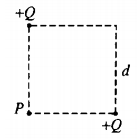
The figure above shows two particles, each with a charge of +Q, that
are located at the opposite corners of a square of side d. 18. What is
the direction of the net electric field at point P ?
(A) ↖
(B) ↗
(C) ↙
(D) ↘
(C)
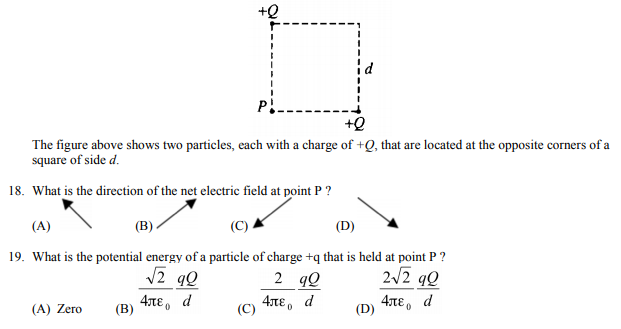
The figure above shows two particles, each with a charge of +Q, that are located at the opposite corners of a square of side d.
What is the potential energy of a particle of charge +q that is
held at point P ?
(A) Zero
(B)
(C)
(D)
(C)
Two parallel conducting plates, separated by a distance d, are
connected to a battery of emf E. Which of the following is correct if
the plate separation is doubled while the battery remains
connected?
(A) The electric charge on the plates is
doubled.
(B) The electric charge on the plates is
halved.
(C) The potential difference between the plates is
doubled.
(E) The capacitance is unchanged.
(B)

The hollow metal sphere shown above is positively charged. Point C is
the center of the sphere and point P is any other point within the
sphere. Which of the following is true of the electric field at these
points?
(A) It is zero at both points.
(B) It is zero at C,
but at P it is not zero and is directed inward.
(C) It is zero at
C, but at P it is not zero and is directed outward.
(D) It is not
zero at either point.
(A)
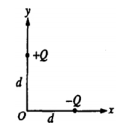
Charges –Q and +Q are located on the x– and y–axes, respectively,
each at a distance d from the origin O, as shown above.
What is
the direction of the electric field at the origin O ?
(A) →
(B) ↖
(C) ↘
(D) ↙
(C)

An electron e and a proton p are simultaneously released from rest in
a uniform electric field E, as shown above. Assume that the particles
are sufficiently far apart so that the only force acting on each
particle after it is released is that due to the electric field. At a
later time when the particles are still in the field, the electron
and
the proton will have the same
(A) direction of motion
(B) speed
(C) magnitude of acceleration
(D) magnitude of force acting on them
(D)

Two large, flat, parallel, conducting plates are 0.04 m apart, as
shown above. The lower plate is at a
potential of 2 V with
respect to ground. The upper plate is at a potential of 10 V with
respect to
ground. Point P is located 0.01 m above the lower
plate.The electric potential at point P is
(A) 10 V (B) 8 V (C) 6
V (D) 4 V
(D)
A particle of charge Q and mass m is accelerated from rest through a
potential difference V, attaining a kinetic energy K. What is the
kinetic energy of a particle of charge 2Q and mass m/2 that is
accelerated from rest through the same potential difference?
(A)
½ K (B) K (C) 2K (D) 4K
(C)

The diagram above shows electric field lines in an isolated region of
space containing two small charged spheres, Y and Z. Which of the
following statements is true?
(A) The charge on Y is negative and
the charge on Z is positive.
(B) The strength of the electric
field is the same everywhere.
(C) The electric field is strongest
midway between Y and Z.
(D) A small negatively charged object
placed at point X would tend to move toward the right.
(D)
A parallel–plate capacitor has a capacitance Co. A second
parallel–plate capacitor has plates with twice the area and twice the
separation. The capacitance of the second capacitor is most
nearly
(A) ¼Co (B) ½Co (C) Co (D) 2Co
(C)
The electric field E just outside the surface of a charged conductor
is
(A) directed perpendicular to the surface
(B) directed parallel to the surface
(C) zero
(D) infinite
(A)

Points R and S are each the same distance d from two unequal charges,
+Q and +2Q, as shown above. The work required to move a charge –Q from
point R to point S is
(A) dependent on the path taken from R to
S
(B) positive
(C) zero
(D) negative
(C)

A rigid insulated rod, with two unequal charges attached to its ends,
is placed in a uniform electric field E as shown above. The rod
experiences a
(A) net force to the left and a clockwise
rotation
(B) net force to the left and a counterclockwise
rotation
(C) net force to the right and a clockwise
rotation
(D) net force to the right and a counterclockwise rotation
(B)
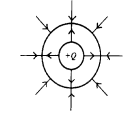
The electric field of two long coaxial cylinders is represented by
lines of force as shown above. The charge on the inner cylinder is +Q.
The charge on the outer cylinder is
(A) +3Q (B) +Q (C) – Q (D) –3 Q
(D)
An isolated capacitor with air between its plates has a potential
difference Vo and a charge Qo. After the space between the plates is
filled with oil, the difference in potential is V and the charge is Q.
Which of the following pairs of relationships is correct?
(A) Q =
Qo and V > Vo
(B) Q = Qo and V < Vo
(C) Q > Qo and V = Vo
(D) Q < Qo and V < Vo
(B)
Two small spheres have equal charges q and are separated by a
distance d. The force exerted on each sphere by the other has
magnitude F. If the charge on each sphere is doubled and d is halved,
the force on each sphere
has magnitude
(A) F (B) 4F (C) 8F
(D) 16F
(D)
Which of the following statements about conductors under
electrostatic conditions is true?
(A) Positive work is required
to move a positive charge over the surface of a conductor.
(B)
Charge that is placed on the surface of a conductor always spreads
evenly over the surface.
(C) The electric potential inside a
conductor is always zero.
(D) The surface of a conductor is
always an equipotential surface.
(D)
A charged particle traveling with a velocity v in an electric field E
experiences a force F that must be
(A) parallel to v
(B) perpendicular to v
(C) parallel to E
(D) perpendicular to E
(C)
A positive charge of 3.0 × 10–8 coulomb is placed in an upward
directed uniform electric field of 4.0 × 104 N/C. When the charge is
moved 0.5 meter upward, the work done by the electric force on the
charge is
(A) 6 × 10–4 J
(B) 12 × 10–4 J
(C) 2 × 104 J
(D) 8 × 104 J
(A)

The following configurations of electric charges are located at the vertices of an equilateral triangle. Point P is equidistant from the charges.
In which configuration is the electric field at P equal to
zero?
(A) A (B) B (C) C (D) D
(A)

The following configurations of electric charges are located at the vertices of an equilateral triangle. Point P is equidistant from the charges.
In which configuration is the electric field at P pointed at
the midpoint between two of the charges?
(A) A (B) B (C) C (D) D
(C)
A sheet of mica is inserted between the plates of an isolated charged
parallel–plate capacitor. Which of the following statements is
true?
(A) The capacitance decreases.
(B) The potential
difference across the capacitor decreases.
(C) The charge on the
capacitor plates decreases
(D) The electric field between the
capacitor plates increases.
(B)

Two conducting spheres, X and Y have the same positive charge +Q, but
different radii
(rx > ry) as shown above. The spheres are
separated so that the distance between them is large compared with
either radius. If a wire is connected between them, in which direction
will electrons be directed in the wire?
(A) From X to Y
(B)
From Y to X
(C) There will be no flow of charge in the
wire.
(D) It cannot be determined without knowing the magnitude
of Q.
(A)
A sphere of radius R has positive charge Q uniformly distributed on its surface.
Which of the following represents the magnitude of the electric
field E and the potential V as functions of r, the distance from the
center of the sphere, when r < R ?
E
V
(A) 0 kQ/R
(B) 0 kQ/r
(C) kQ/r2 0
(D)
kQ/R2 0
(A)
A sphere of radius R has positive charge Q uniformly distributed on its surface.
Which of the following represents the magnitude, of the electric field E and the potential V as functions of r, the distance from the center of sphere, when r > R ?
E
V
(A) kQ/R2 kQ/R
(B) kQ/R kQ/r
(C)
kQ/r2 kQ/r
(D) kQ/r2 kQ/r
(C)
From the electric field vector at a point, one can determine which of
the following?
I. The direction of the electrostatic force on a
test charge of known sign at that point
II. The magnitude of the
electrostatic force exerted per unit charge on a test charge at that
point
III. The electrostatic charge at that point
(A) I only
(B) III only
(C) I and II only
(D) II and III only
(C)
A conducting sphere of radius R carries a charge Q. Another
conducting sphere has a radius R/2, but carries the same charge. The
spheres are far apart. The ratio of the electric field near the
surface of the smaller sphere to
the field near the surface of
the larger sphere is most nearly
(A) 1/4 (B) 1/2 (C) 2 (D) 4
(D)
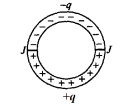
A circular ring made of an insulating material is cut in half. One
half is given a charge –q uniformly distributed along its arc. The
other half is given a charge + q also uniformly distributed along its
arc. The two halves are then rejoined with insulation at the junctions
J, as shown above. If there is no change in the charge distributions,
what is the direction of the net electrostatic force on an electron
located at the center of the circle?
(A) Toward the top of the page
(B) Toward the bottom of the page
(C) To the right
D) To the left
(B)

Four positive charges of magnitude q are arranged at the corners of a
square, as shown above. At the center C of the square, the potential
due to one charge alone is Vo and the electric field due to one charge
alone has magnitude Eo. Which of the following correctly gives the
electric potential and the magnitude of the electric field at the
center of the square due to all four charges?
Electric
Potential Electric
Field
(A) Zero Zero
(B) Zero 2Eo
(C) 4 Vo Zero
(D) 4 Vo 2Eo
(C)

Two charges, –2Q and +Q, are located on the x–axis, as shown above.
Point P, at a distance of 3D from the origin O, is one of two points
on the positive x–axis at which the electric potential is zero. How
far from the origin O is the other point?
(A) 2/3 D
(B) 3/2 D
(C) 5/3 D
(D) 2D
(C)
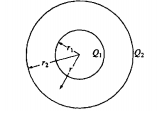
Two concentric, spherical conducting shells have radii r1 and r2 and
charges Q1 and Q2, as shown above. Let r be the distance from the
center of the spheres and consider the region r1 < r < r2. In
this region the electric field is proportional to
(A) Q1/r2
(B) (Q1 + Q2)/r2
(C) (Q1 + Q2)/r
(D) Q1/r + Q2/r2
(A)
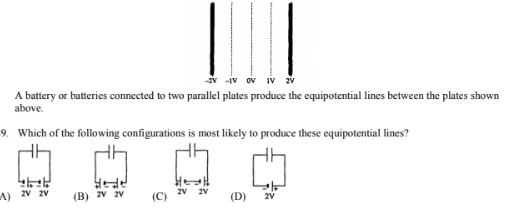
Which of the following configurations is most likely to produce these equipotential lines?
(A)
(B)
(C)
(D)
(A)
The force on an electron located on the 0 volt potential line
is:
(A) 0 N
(B) 1 N, directed to the right
(C) 1 N, directed to the left
(D) to the right, but its magnitude cannot be determined without knowing the distance between the lines
(D)

Two metal spheres that are initially uncharged are mounted on
insulating stands, as shown above. A negatively
charged rubber
rod is brought close to, but does not make contact with, sphere X.
Sphere Y is then brought close to X on the side opposite to the rubber
rod. Y is allowed to touch X and then is removed some distance away.
The rubber rod is then moved far away from X and Y. What are the final
charges on the spheres?
Sphere
X Sphere
Y
A) Zero Zero
B) Negative
Positive
C) Positive Negative
D) Positive Positive
(C)
Two initially uncharged conductors, 1 and 2, are mounted on
insulating stands and are in contact, as shown above. A negatively
charged rod is brought near but does not touch them. With the rod held
in place, conductor 2 is moved to the right by pushing its stand, so
that the conductors are separated. Which of the following is now true
of conductor 2?
(A) It is uncharged.
(B) It is positively charged.
(C) It is negatively charged.
(D) It is charged, but its sign cannot be predicted.
(C)
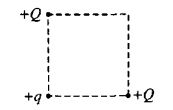
As shown above, two particles, each of charge +Q, are fixed at opposite corners of a square that lies in the plane of the page. A positive test charge +q is placed at a third corner. What is the direction of the force on the test charge due to the two other charges?
(A) ↘
(B) ↗
(C) ↓
(D) ↙
(D)
If F is the magnitude of the force on the test charge due to only one of the other charges, what is the magnitude of the net force acting on the test charge due to both of these charges?
(A) Zero
(B) F/ √2
(D) √2F
(E) 2
(D)

Two charges are located on the line shown in the figure below, in which the charge at point I is +3q and the charge at point III is +2q. Point II is halfway between points I and III.
Other than at infinity, the electric field strength is zero at a point on the line in which of the following ranges?
- To the left of I
- Between I and II
- Between II and III
- To the right of III
(C)
Two charges are located on the line shown in the figure below, in which the charge at point I is +3q and the charge at point III is +2q. Point II is halfway between points I and III.
The electric potential is negative at some points on the line in
which of the following ranges?
(A) To the left of I
(B) Between I and II
(C) Between II and III
(D) None; this potential is never negative.
(D)
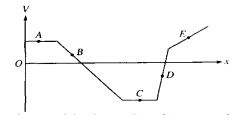
The graph above shows the electric potential V in a region of space
as a function of position along the x–axis.
At which point would
a charged particle experience the force of greatest
magnitude?
(A) A (B) B (C) D (D) E
(C)
If the only force acting on an electron is due to a uniform electric
field, the electron moves with constant
(A) acceleration in a
direction opposite to that of the field
(B) acceleration in the
direction of the field
(C) speed in a direction opposite to that
of the field
(D) speed in the direction of the field
(A)

Two charged particles, each with a charge of +q, are located along the x–axis at x = 2 and x = 4, as shown above. Which of the following shows the graph of the magnitude of the electric field along the x–axis from the origin to x = 6?
(A)
A positive electric charge is moved at a constant speed between two
locations in an electric field, with no work done by or against the
field at any time during the motion. This situation can occur only if
the:
(A) charge is moved in the direction of the field
(B)
charge is moved opposite to the direction of the field
(C) charge
is moved perpendicular to an equipotential line
(D) charge is
moved along an equipotential line
(D)
The nonconducting hollow sphere of radius R shown above carries a
large charge +Q, which is uniformly
distributed on its surface.
There is a small hole in the sphere. A small charge +q is initially
located at point P a distance r from the center of the sphere. If k =
1/4πεo, what is the work that must be done by an external agent in
moving the charge +q from P through the hole to the center O of the
sphere?
(A) kqQ/r
(B) kqQ/R
(C) kq(Q – q)/r
(D) kqQ(1/R – 1/r)
(D)
A capacitor is constructed of two identical conducting plates parallel to each other and separated by a distance d. The capacitor is charged to a potential difference of V0 by a battery, which is then disconnected
If any edge effects are negligible, what is the magnitude of the
electric field between the plates?
(A) V0d
(B) V0/d
(C) V0/d2
(D) V0 2/d
(B)
A capacitor is constructed of two identical conducting plates parallel to each other and separated by a distance d. The capacitor is charged to a potential difference of V0 by a battery, which is then disconnected.
A sheet of insulating plastic material is inserted between the
plates without otherwise disturbing the system. What effect does this
have on the capacitance?
(A) It causes the capacitance to
increase.
(B) It causes the capacitance to decrease.
(C)
None; the capacitance does not change.
(E) Nothing can be said
about the effect without knowing the thickness of the sheet.
(A)

A point charge +Q is inside an uncharged conducting spherical shell
that in turn is near several isolated point charges, as shown above.
The electric field at point P inside the shell depends on the
magnitude of:
(A) Q only
(B) the charge distribution on the
sphere only
(C) Q and the charge distribution on the
sphere
(D) all of the point charges
(A)
A potential difference V is maintained between two large, parallel
conducting plates. An electron starts from
rest on the surface of
one plate and accelerates toward the other. Its speed as it reaches
the second plate is
proportional to
(A) 1/ √V
(B) √V
(C) V
(D) V2
(B)

Particles of charge Q and –4Q are located on the x–axis as shown in the figure above. Assume the particles are isolated from all other charges.
66. Which of the following describes the direction of the
electric field at point P?
(A) +y
(B)–y
(C) Components in both the –x and +y directions
(D) Components in both the +x and –y directions
(D)

Particles of charge Q and –4Q are located on the x–axis as shown in the figure above. Assume the particles are isolated from all other charges.
At which of the labeled points on the x–axis is the electric
field zero?
(A) A (B) B (C) C (D) E
(A)
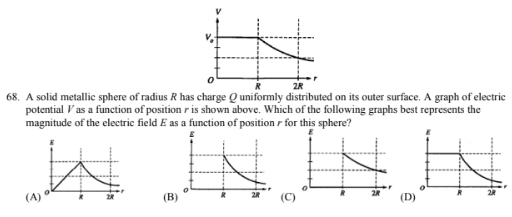
A solid metallic sphere of radius R has charge Q uniformly distributed on its outer surface. A graph of electric potential V as a function of position r is shown above. Which of the following graphs best represents the magnitude of the electric field E as a function of position r for this sphere?
(B)

As shown in the figure above, six particles, each with charge +Q, are held fixed and ate equally spaced around the circumference of a circle of radius R.
69. What is the magnitude of the resultant electric field at the center of the circle?
(A)
(B)
(C)
(D)
(A)

As shown in the figure above, six particles, each with charge +Q, are held fixed and ate equally spaced around the circumference of a circle of radius R.
With the six particles held fixed, how much work would be required to bring a seventh particle of charge + Q from very far away and place it at the center of the circle?
(A)
(B)
(C)
(D)
(D)
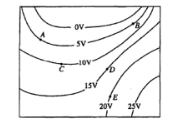
The diagram above shows equipotential lines produced by an unknown
charge distribution. A, B, C, D, and E
are points in the
plane.
71. Which vector below best describes the direction of the
electric field at point A ?
(A)↗
(B)↙
(C)↘
(D)↖
(A)

At which point does the electric field have the greatest
magnitude?
(A) A (B) B (C) C (D) E
(B)

How much net work must be done by an external force to move a –1 μC
point charge from rest at point C to rest at point E ?
(A) –20 μJ
(B) –10 μJ (C) 10 μJ (D) 20 μJ
(B)
A physics problem starts: "A solid sphere has charge distributed
uniformly throughout. . . " It may be correctly
concluded
that the
(A) electric field is zero everywhere inside the
sphere
(B) electric potential on the surface of the sphere is not
constant
(C) electric potential in the center of the sphere is
zero
(D) sphere is not made of metal
(D)
A uniform spherical charge distribution has radius R.. Which of the
following is true of the electric field strength due to this charge
distribution at a distance r from the center of the charge?
(A)
It is greatest when r = 0.
(B) It is directly proportional to r
when r > R.
(C) It is directly proportional to r when r <
R.
(D) It is directly proportional to r2
(C)
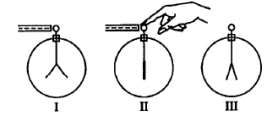
When a negatively charged rod is brought near, but does not touch,
the initially uncharged electroscope shown above, the leaves spring
apart (I). When the electroscope is then touched with a finger, the
leaves collapse (II). When next the finger and finally the rod are
removed, the leaves spring apart a second time (III). The charge on
the leaves is:
(A) positive in both I and III
(B) negative
in both I and III
(C) positive in I, negative in III
(D)
negative in I, positive in III
(B)
A positively charged conductor attracts a second object. Which of the
following statements could be true?
I. The second object is a
conductor with negative net charge.
II. The second object is a
conductor with zero net charge.
III. The second object is an
insulator with zero net charge..
(A) I only (B) II only (C) III
only (D) I, II & III
(D)

A point charge of +4.0 μC is placed on the negative x–axis 0.20 m to
the left of the origin, as shown in the accompanying figure. A second
point charge q is placed on the positive x–axis 0.30 m to the right of
the origin.
If the net electric field at the origin is
zero. What is q?
(A) +9.0 μC
(B) +6.0 μC
(C) –6.0 μC
(D) –9.0 μC
(A)

A point charge of +4.0 μC is placed on the negative x–axis 0.20 m to the left of the origin, as shown in the accompanying figure. A second point charge q is placed on the positive x–axis 0.30 m to the right of the origin.
If the net electric potential at the origin is zero. What is
q?
(A) +9.0 μC
(B) +6.0 μC
(C) –6.0 μC
(D) –9.0 μC
(C)

A small object with charge q and weight mg is attached to one end of
a string of length L. The other end is attached to a stationary
support. The system is placed in a uniform horizontal electric field
E, as shown in the accompanying figure. In the presence of the field,
the string makes a constant angle q with the vertical. What is the
sign and magnitude of q?
(A) positive with magnitude
mg/E
(B) negative with magnitude mg/E
(C) positive with
magnitude (mg/E)tanθ
(D) negative with magnitude (mg/E)tanθ
(C)
Two large parallel plates a distance d apart are charged by
connecting them to a battery of potential difference V. The battery is
disconnected, and the plates are slowly moved apart. As the distance
between plates increases:
(A) the charge on the plates
decreases.
(B) the electric field intensity between the plates
increases.
(C) the potential difference between the plates
decreases.
(D) the potential difference between the plates increases.
(D)
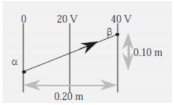
In the figure above, equipotential lines are drawn at 0, 20.0 V, and
40.0 V. The total work done in moving a point charge of + 3.00 mC from
position a to position b is:
(A) 4.00 mJ
(B) 8.00 mJ
(C) 12.0 mJ
(D) 120 mJ
(D)
Two positive point charges repel each other with force 0.36 N when
their separation is 1.5 m. What force do they exert on each other when
their separation is 1.0 m?
(A) 0.81 N
(B) 0.54 N
(C)
0.24 N
(D) 0.16 N
(A)
Two isolated conducting spheres (S1 of radius 0.030 m and initial
charge + 6.0 nC and S2 of radius 0.040 m and initial charge + 2.0 nC)
are connected by a conducting wire. Charge will flow in the wire
until:
(A) both spheres are equally charged.
(B) the force
of repulsion between the two spheres becomes equal.
(C) both
spheres have the same surface charge density.
(D) both spheres
are at the same potential.
(D)
A point charge +q is placed midway between two point charges +3q and –q separated by a distance 2d. If Coulomb’s constant is k, the magnitude of the force on the charge +q is:
(A) 2kq2/d2
(B)
4kq2/d2
(C) 6kq2/d2
(D) 8kq2/d2
(B)

A charged rod is placed between two insulated conducting spheres as
shown. The spheres have no net charge.
Region II has the
same polarity as Region:
(A) I only (B) III only (C) IV
only (D) I & IV only
(B)
Two large oppositely charged insulated plates have a uniform electric
field between them. The distance between the plates is increased.
Which of the following statements is true?
I. The field
strength decreases.
II. The field strength increases.
III.
The potential difference between the plates increases.
(A) I only (B) II only (C) III only (D) I and III only
(C)
When two charged point–like objects are separated by a distance R,
the force between them is F. If the distance between them is
quadrupled, the force between them is:
(A) 16 F (B) 4 F
(C) F/4 (D) F/16
(D)
An electroscope is given a positive charge, causing its foil leaves
to separate. When an object is brought near the top plate of the
electroscope, the foils separate even further. We could
conclude:
(A) that the object is positively
charged.
(B) that the object is negatively charged.
(C)
only that the object is charged.
(D) only that the object is uncharged.
(A)

Four positive point charges are arranged as shown in the accompanying
diagram. The force between charges 1 and 3 is 6.0 N; the force between
charges 2 and 3 is 5.0 N; and the force between charges 3 and 4 is 3.0
N. The magnitude of the total force on charge 3 is most nearly:
(A) 6.3 N (B) 8.0 N (C) 11 N (D) 14 N
(A)
Two isolated parallel plates are separated by a distance d. They
carry opposite charges Q and each has surface area A. Which of the
following would increase the strength of the electric field between
the plates?
I. Increasing Q
II. Increasing
A
III. Increasing d
(A) I only (B) II only (C) III
only (D) II & III only
(A)
When a positive electrically charged glass rod is brought near a
neutral hollow metal sphere suspended by an insulating string, the
sphere will be attracted to the rod because:
(A) the rod
removes electron from the sphere
(B) the electric charge
produces a magnetic field to attract the sphere
(C) the charge
on the rod causes a separation of charge in the sphere
(D) some
of the protons from the rod have been given to the sphere
(C)

An alpha particle and a proton are placed equal distance between two
large charged metal plates as shown. Which of the following would best
describe the motion of the two particles if they were free to
move?
(A) The alpha particle will travel upwards with
twice the velocity of the proton.
(B) Both particles will travel
upwards with the same velocity.
(C) Both particles will
accelerate upwards with the same acceleration.
(D) The alpha
particle will accelerate upwards with half the acceleration of the proton
(D)
Two parallel metal plates carry opposite electrical charges each with
a magnitude of Q. The plates are separated by a distance d and each
plate has an area A. Consider the following:
I. increasing
Q
II. increasing d
III. increasing A
Which of
the following would have the effect of reducing the potential
difference between the plates?
(A) I only (B) II only (C) III
only (D) II and III
(C)
A positive point charge of +q and a negative point charge of –q are
separated by a distance d. What would be the magnitude of the electric
field midway between the two charges?
(A) E =
kq/d2
(B) E = 2kq/d2
(C) E =
4kq/d
(D) E = 8kq/d2
(D)
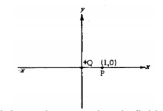
A positive charge +Q located at the origin produces an electric field
E0 at point P (x = +1, y = 0). A negative charge –2Q is placed at such
a point as to produce a net field of zero at point P. The second
charge will be placed on the:
(A) x-axis where x > 1
(B) x-axis where x < 0
(C) y-axis where y > 0
(D) y-axis where y < 0
(B)

A 300 eV electron is aimed midway between two parallel metal plates
with a potential difference of 400 V. The electron is deflected
upwards and strikes the upper plate as shown. What would be the
kinetic energy of the electron just before striking the metal
plate?
(A) 360 eV
(B) 400 eV
(C) 500 eV
(D) 700 eV
(C)

Two small hollow metal spheres hung on insulating threads attract one
another as shown. It is known that a positively charged rod will
attract ball A.
I. Ball A has a positive charge
II. Ball B
has a negative charge
III. Ball A and Ball B have opposite
charges
Which of the above can be correctly concluded
about the charge on the balls?
(A) I only (B) II only (C)
III only (D) none of these
(D)
A 5x10-6 coulomb electric charge is placed midway between
two parallel metal plates connected to a 9–volt battery. If the
electric charge experiences a force of 1.5x10–4 newtons, what is the
separation of the metal plates?
(A) 6.75 ×
10-9 m
(B) 2.7 × 10-4 m
(C) 3.7 ×
10-3 m
(D) 0.30 m
(D)
A parallel–plate capacitor is connected with wires of negligible
resistance to a battery having emf E until the capacitor is fully
charged. The battery is then disconnected from the circuit and the
plates of the capacitor are moved to half of their original separation
using insulated gloves. Let Vnew be the potential
difference across the
capacitor plates when the plates are moved
together. Let Vold be the potential difference across the capacitor
plates when connected to the battery.
Vnew /
Vold =
(A) ½
(B) 1
(C) 2
(D) 4
(A)

A solid, uncharged conducting sphere of radius 3a contains a hollowed
spherical region of radius a. A point charge +Q is placed at the
common center of the spheres. Taking V = 0 as r approaches infinity,
the potential at position r = 2 a from the center of the spheres
is:
(A) 0
(B) 2kQ/3a
(C) kQ/3a
(D) kQ/a
(C)
Two identical electrical point charges Q, separated by a distance d
produce an electrical force of F on one another. If the distance is
decreased to a distance of 0.40d, what is the strength of the
resulting force?
(A) 6.3F
(B) 2.5F
(C) 0.40F
(D) 0.16F
(A)
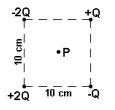
Four electrical charges are arranged on the corners of a 10 cm square
as shown.
What would be the direction of the resulting electric
field at the center point P?
(A) →
(B) ↑
(C) ↓
(D) ↗
(B)

A proton is released between the two parallel plates of the fully
charged capacitor shown above. What would be the resulting
acceleration of the proton?
(A) 7.3 × 1013
m/s2
(B) 9.6 × 108 m/s2
(C) 6.3 × 1019 m/s2
(D) 3.8 ×
1011 m/s2
(D)
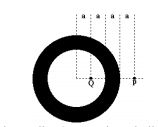
A solid uncharged conducting sphere has radius 3a contains a hollowed spherical region of radius 2a. A point charge +Q is placed at a position a distance a from the common center of the spheres. What is the magnitude of the electric field at the position r = 4a from the center of the spheres as marked in the figure by P?
(A) 0
(B) kQ/16a2
(C) 3kQ/16a2
(D) kQ/9a2
(B)
A positively charged object is brought near but not in contact with
the top of an uncharged gold leaf electroscope. The experimenter then
briefly touches the electroscope with a finger. The finger is removed,
followed by the removal of the positively charged object. What happens
to the leaves of the electroscope when a negative charge is now
brought near but not in contact with the top of the
electroscope?
(A) they remain uncharged
(B) they
move farther apart
(C) they move closer together
(D) they
remain negatively charged but unmoved
(B)
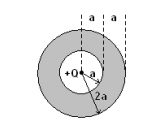
A solid spherical conducting shell has inner radius a and outer
radius 2a. At the center of the shell is located a point charge +Q.
What must the excess charge of the shell be in order for the charge
density on the inner and outer surfaces of the shell to be exactly
equal?
(A) –5Q
(B) +3Q
(C) –4Q
(D) +4Q
(A)
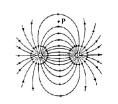
A small positive test charge is placed at point P in the region near two charges. Which of the following arrows indicates the direction of the force on the positive test charge?
(A) →
(B) ↓
(C) ←
(D) ↘
(C)
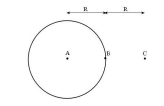
A spherical conducting shell has a net charge +Q placed on it. Which
of the following is the correct
relationship for the electric
potential at the points labeled A, B, and C? Point A is at the center
of the sphere, point B is at the surface of the shell, a distance R
from point A, and point C is a distance R from point B outside the
sphere. As r goes to infinity, V = 0.
(A) VC < VB <
VA
(B) VA < VB < VC
(C) VC = VB = VA
(D) VC
< VB = VA
(D)
Which statement about a system of point charges that are fixed in
space is necessarily true?
(A) If the potential energy of
the system is negative, net positive work by an external agent is
required to take the charges in the system back to infinity.
(B) If the potential energy of the system is positive, net
positive work is required to bring any new charge not part of the
system in from infinity to its final resting location.
(C) If the potential energy of the system is zero, no negative
charges are in the configuration.
(D) If the potential
energy of the system is negative, net positive work by an external
agent was required to assemble the system of charges.
(A)
A positive point charge exerts a force of magnitude F on a negative
point charge placed a distance x away. The negative point charge is
replaced with a positive point charge and the distance between the two
point charges is
halved. What is the magnitude of the new force
that the positive point charge exerts on the negative point charge?
(A) 4F
(B) 2F
(C) F
(D) F/2
(A)
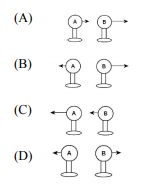
Two uniformly charged non–conducting spheres on insulating bases are placed on an air table. Sphere A has a charge +3Q coulombs and sphere B has a charge +Q coulombs. Which of the following correctly illustrates the magnitude and direction of the electrostatic force between the spheres when they are released?
(A)
(B)
(C)
(D)
(D)

For the diagram shown above, what is the ratio of the charges q2/q1 where the diagram shown has a representation of the field lines in the space near the charges?
(A) -3/2
(B) -2/3
(C) 2/3
(D) 3/2
(B)

Two point charges are fixed on the x–axis in otherwise empty space as shown above.
In which Region(s) is there a place on the x–axis (aside from
infinity) at which the electric potential is equal to zero?
(A) Only in Region II
(B) In both Regions I and
II
(C) In both Regions I and III
(D) In both Regions II and III
(D)

Two point charges are fixed on the x–axis in otherwise empty space as shown above.
In which Region(s) is there a place on the x–axis (aside from
infinity) at which the electric field is equal to zero?
(A) Only in Region I
(B) In both Regions I and II
(C) Only in Region III
(D) In both Regions II and III
(C)
A parallel–plate capacitor is connected to a battery. Without
disconnecting the capacitor, a student pulls the capacitor’s plates
apart so that the plate separation doubles. As a result of this
action, what happens to the voltage across the capacitor and the
energy stored by the capacitor?
(A) the voltage doubles;
the energy stays the same
(B) the voltage doubles; the energy
halves
(C) the voltage stays the same; the energy
halves
(D) the voltage stays the same; the energy doubles
(C)
A person rubs a neutral comb through their hair and the comb becomes
negatively charged. Which of the following is the best explanation for
this phenomenon?
(A) The hair gains protons from the
comb.
(B) The hair gains protons from the comb while giving
electrons to the comb.
(C) The hair loses electrons to the
comb.
(D) The comb loses protons to the person’s hand holding
the comb.
(C)

A charge of +Q is located on the x–axis at x = –1 meter and a charge
of –2Q is held at x = +1 meter, as shown in the diagram above. At what
position on the x–axis will a test charge of +q experience a zero net
electrostatic force?
(A) – 3 √8 m (B) –1/3 m (C) 1/3 m
(D) 3 √8 m
(A)
The two plates of a parallel-plate capacitor are a distance d apart
and are mounted on insulating supports. A battery is connected across
the capacitor to charge it and is then disconnected. The distance
between the insulated plates is then increased to 2d. If fringing of
the field is still negligible, which of the following quantities is
doubled?
(A) The capacitance of the capacitor
(B)
The surface density of the charge on the plates of the
capacitor
(C) The energy stored in the capacitor
(D) The
intensity of the electric field between the plates of the capacitor
(C)
Two point objects each carrying charge 10Q are separated by a
distance d. The force between them is F. If half the charge on one
object is transferred to the other object while at the same time the
distance between them is
doubled, what is the new force between
the two objects?
(A) 0.19 F (B) 0.25 F (C) 0.75 F (D) 4.0 F
(A)
Two identical spheres carry identical electric charges. If the
spheres are set a distance d apart they repel one another with a force
F. A third sphere, identical to the other two but initially uncharged
is then touched to one sphere and then to the other before being
removed. What would be the resulting force between the original two
spheres?
(A) ¾ F (B) 5/8 F (C) ½ F (D) 3/8 F
(D)
An alpha particle is accelerated to a velocity v in a particle
accelerator by a potential difference of 1200 V.
Which of
the following potential differences would be needed to give the alpha
particle twice the velocity?
(A) 4800 V (B) 4100 V (C)
2400 V (D) 1700 V
(A)
An electrical charge Q is placed at one vertex of an equilateral
triangle. When an identical charge is placed at another vertex, each
charge feels a force of 15 N. When a third charge identical to the
first two, is placed at the third vertex, what would be the magnitude
of the force on each charge?
(A) 15 N (B) 26 N (C) 30 N
(D) 42 N
(B)
Two conducting spheres with the same charge Q are separated by an
infinite distance. Sphere A has a radius of 10 cm while sphere B has a
radius of 20 cm. At what distance from the centers of the spheres
would the magnitude of the electric field be the same?
(A) 15 cm from A and 15 cm from B
(B) 30 cm from A and 40
cm from B
(C) 20 cm from A and 40 cm from B
(D) 40 cm from
A and 40 cm from B
(D)

A large conducting sphere labeled X contains an electrical charge Q.
Sphere X is connected by a metal wire to a small uncharged conducting
sphere labeled Y. The wire is then removed. How does the electrical
field (Ey) at the surface of sphere Y compare to the
electrical field (Ex) at the surface of sphere X?
(A)
Ex = Ey = 0
(B) Ey= Ex
≠0
(C) Ey< Ex
(D)
Ey> Ex
(D)
What voltage would be required across a 8.9 nF capacitor to
accumulate 1.5 × 1012 excess electrons on one plate of the
capacitor?
(A) 3.7 V (B) 5.9 V (C) 14 V (D) 27 V
(D)

A hollow metal sphere is uniformly charged with positive charge.
Points K and L are inside the sphere and points M and N are outside
the sphere as shown in the diagram. At which pair of points would the
field be the smallest?
(A) points K and N
(B) points L and
M
(C) points K and L
(D) points M and N
(C)
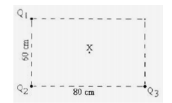
Three electric charges (Q1, Q2, and Q3) are arranged at three corners
of a rectangle as shown in the diagram and each has a charge of -40
nC.
What is the magnitude of the net force on Q2?
(A) 1.4 × 10-5 N
(B) 1.7 × 10-5 N
(C) 4.2 × 10-5 N
(D) 4.6 × 10-5 N
(D)

Three electric charges (Q1, Q2, and Q3) are arranged at three corners of a rectangle as shown in the diagram and each has a charge of -40 nC.
What would be the magnitude of the total electric field at center
point X?
(A) 1440 N/C
(B) 720 N/C
(C) 360 N/C
(D) 180 N/C
(A)

Which of the following graphs would best represent the electric field of a hollow sphere as a function of distance from its center when it is charged to a potential of 400,000 volts?
(A)
(B)
(C)
(D)
(D)
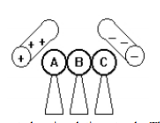
Three metal spheres A, B, and C are mounted on insulating stands. The
spheres are touching one another, as shown in the diagram below. A
strong positively charged object is brought near sphere A and a strong
negative charge is brought near sphere C. While the charged objects
remain near spheres A and C, sphere B is removed by means of its
insulating stand. After the charged objects are removed, sphere B is
first touched to sphere A and then to sphere C. The resulting charge
on B would be of what relative amount and sign?
(A) the
same sign but 1/2 the magnitude as originally on sphere A
(B)
the opposite sign but 1/2 the magnitude as originally on sphere
A
(C) the opposite sign but 1/4 the magnitude as originally on
sphere A
(D) the same sign but 1/2 the magnitude as originally
on sphere C
(C)

A charge is uniformly distributed through a volume of radius a. Which of the graphs below best represents the magnitude of the electric field as a function of distance from the center of the sphere?
(A)
(B)
(C)
(D)
(C)
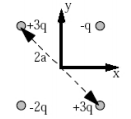
Four point charges are placed at the corners of a square with
diagonal 2a as shown in the diagram. What is the total electric field
at the center of the square?
(A) kq/a2 at an
angle 45° above the +x axis.
(B) kq/a2 at an angle
45° below the –x axis.
(C) 3kq/a2 at an angle 45°
above the –x axis.
(D) 3kq/a2 at an angle 45° below
the +x axis.
(B)

A free electron and a free proton are placed between two oppositely
charged parallel plates. Both are closer to the positive plate than
the negative plate. See the diagram below. Which of the following
statements is true?
I. The force on the proton is greater
than the force on the electron.
II. The potential energy of the
proton is greater than that of the electron.
III. The potential
energy of the proton and the electron is the same.
(A)
II only (B) III only (C) I & II only (D) I & III only
(A)

A spherical shell with an inner surface of radius a and an outer surface of radius b is made of conducting material. A charge +Q is placed at the center of the spherical shell and a total charge –q is placed on the shell.
How is the charge –q distributed after it has reached
equilibrium?
(A) +Q on the inner surface, – q – Q on the
outer surface.
(B) The charge –q is spread uniformly between the
inner and outer surface.
(C) –Q on the inner surface, – q + Q on
the outer surface.
(D) –Q on the inner surface, –q on the outer surface.
(C)

A spherical shell with an inner surface of radius a and an outer surface of radius b is made of conducting material. A charge +Q is placed at the center of the spherical shell and a total charge –q is placed on the shell.
What is the electrostatic potential at a distance R from the center
of the shell, where b < R < a?
(A) kQ/a
(B) kQ/R
(C) k(Q – q)/R
(D) k(Q – q)/b
(D)
Conducting sphere X is initially uncharged. Conducting sphere Y has
twice the diameter of sphere X and initially has charge q. If the
spheres are connected by a long thin wire, which of the following is
true once equilibrium has been reached?
(A) Sphere Y has
half the potential of sphere X. (B) Spheres X and Y have the same
potential.
(C) Sphere Y has half the charge of sphere X.
(D) Spheres X and Y have the same charge
(B)
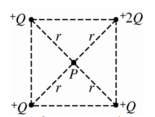
Four positive charges are fixed at the corners of a square, as shown above. Three of the charges have magnitude Q, and the fourth charge has a magnitude 2Q. Point P is at the center of the square at a distance r from each charge.
What is the electric potential at point P?
(A) Zero
(B)
2kQ/r
(C) 4kQ/r
(D) 5kQ/r
(D)

Four positive charges are fixed at the corners of a square, as shown above. Three of the charges have magnitude Q, and the fourth charge has a magnitude 2Q. Point P is at the center of the square at a distance r from each charge.
What is the magnitude of the electric field at point P ?
(A)
kQ/r2
(B) 2kQ/r2
(C)
4kQ/r2
(D) 5kQ/r2
(A)

The two charged metal spheres X and Y shown above are far apart, and
each is isolated from all other charges. The radius of sphere X is
greater than that of sphere Y, and the magnitudes of the electric
fields just outside their surfaces are the same. How does the charge
on sphere X compare with that on sphere Y?
(A) It is
greater.
(B) It is less.
(C) It is the same.
(D It
cannot be determined without knowing the actual value of the electric
field just outside the spheres
(A)
Two negative point charges are a distance x apart and have potential
energy U. If the distance between the point charges increases to 3x,
what is their new potential energy?
(A) 9U (B) 3U (C) 1/3
U (D) 1/9 U
(C)
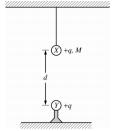
Sphere X of mass M and charge +q hangs from a string as shown above.
Sphere Y has an equal charge +q and is fixed in place a distance d
directly below sphere X. If sphere X is in equilibrium, the tension in
the string is most
nearly:
(A) Mg + kq/d
(B)
Mg – kq/d
(C) Mg + kq2/d2
(D) Mg – kq2/d2
(D)
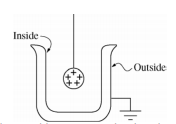
A small positively charged sphere is lowered by a nonconducting
thread into a grounded metal cup without touching the inside surface
of the cup, as shown above. The grounding wire attached to the outside
surface is disconnected and the charged sphere is then removed from
the cup. Which of the following best describes the subsequent
distribution of excess charge on the surface of the cup?
(A) Negative charge resides on the inside surface, and no charge
resides on the outside surface.
(B) Negative charge resides on
the outside surface, and no charge resides on the inside
surface.
(C) Positive charge resides on the inside surface, and
no charge resides on the outside surface.
(D) Positive charge
resides on the outside surface, and no charge resides on the inside surface
(B)
A helium nucleus (charge +2q and mass 4m) and a lithium nucleus
(charge +3q and mass 7m) are accelerated through the same electric
potential difference, V0. What is the ratio of their resultant kinetic
energies, Klithium/Khelium ?
(A)
2/3 (B) 6/7 (C) 7/6 (D) 3/2
(D)

A point charge −Q is located at the origin, while a second point
charge +2Q is located at x = d on the x-axis, as shown above. A point
on the x-axis where the net electric field is zero is located in which
of the following regions?
(A) -∞ < x < 0
(B)
0 < x < d/2
(C) d/2 < x < d
(D) d < x < ∞
(A)
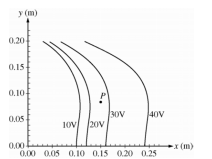
A fixed charge distribution produces the equipotential lines shown in
the figure above.
Which of the following expressions best
represents the magnitude of the electric field at point P ?
(A) 10 V/0.14 m
(B) 10 V/0.04 m
(C) 25 V/0.14 m
(D) 25 V/0.04 m
(B)

A fixed charge distribution produces the equipotential lines shown in the figure above.
The direction of the electric field at point P is most
nearly:
(A) toward the left
(B) toward the
right
(C) toward the bottom of the page
(D) toward the top
of the page
(A)
A cloud contains spherical drops of water of radius R and charge Q.
Assume the drops are far apart. If two droplets happen to combine into
a single larger droplet, the new potential V at the surface of the
larger droplet is most nearly equal to:
(A)
2V0
(B) (2/∛2) V0
(C)
∛2V0
(D) V0
(B)

Two protons and an electron are assembled along a line, as shown
above. The distance between the electron and
each proton is a.
What is the work done by an external force in assembling this
configuration of charges?
(A) –2ke2/a
(B) –3ke2/2a
(C) ke2/2a
(D) 3ke2/a
(B)